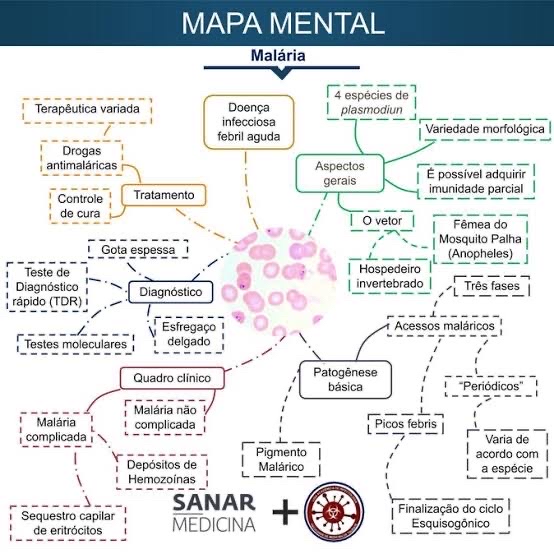
mapa mental malaria Parasitologia
Malaria is a parasitic infection transmitted by the Anopheles mosquito that leads to acute life-threatening disease and poses a significant global health threat. Two billion people risk contracting malaria annually, including those in 90 endemic countries and 125 million travelers, and 1.5 to 2.7 million people die in a year.[1] The Plasmodium parasite has a multistage lifecycle, which leads.

mapa mental de malária Parasitologia
Malária Plasmodium P. vivax (BRA) Tratamento: cloroquina e primaquina P. falciparum (BRA) Tratamento: artemisinina P. malariae (BRA) P. ovale P. knowlesi Inoculação de promastigotas durante o repasto sanguíneo do mosquito fêmea do gênero Anophele

MAPA MENTAL SOBRE MALÁRIA Maps4Study
A Malária é uma doença infecciosa febril aguda, causada por protozoários transmitido pela fêmea infectada do mosquito Anopheles, ou seja, é uma doença infecciosa não contagiosa. A Malária pode ser causada por 4 principais espécies de Plasmodium, dispostas a seguir, por ordem de letalidade:

Infográficos MALÁRIA by Carla Quijada BioBlog ESEM Medium
PAHO's Former Directors. Executive Management. Organizational Chart. Statement of Assessed Contributions due from Member States. What We Do. Communicable Disease Prevention, Control, and Elimination. Comprehensive Immunization. Evidence and Intelligence for Action in Health. Innovation, Access to Medicines and Health Technologies.
malaria Mind Map
Malaria The problem of malaria (epidemiology) Endemic in parts of; Asia Africa (malaria belt - subsaharan) Latin america Oceania 41% of the worlds population live in regions where malaria is transmitted 200-500 million cases each year 1-2 million deaths each year 75% of these are kids in africa = 2,700 deaths each day (1 death every 30 seconds)
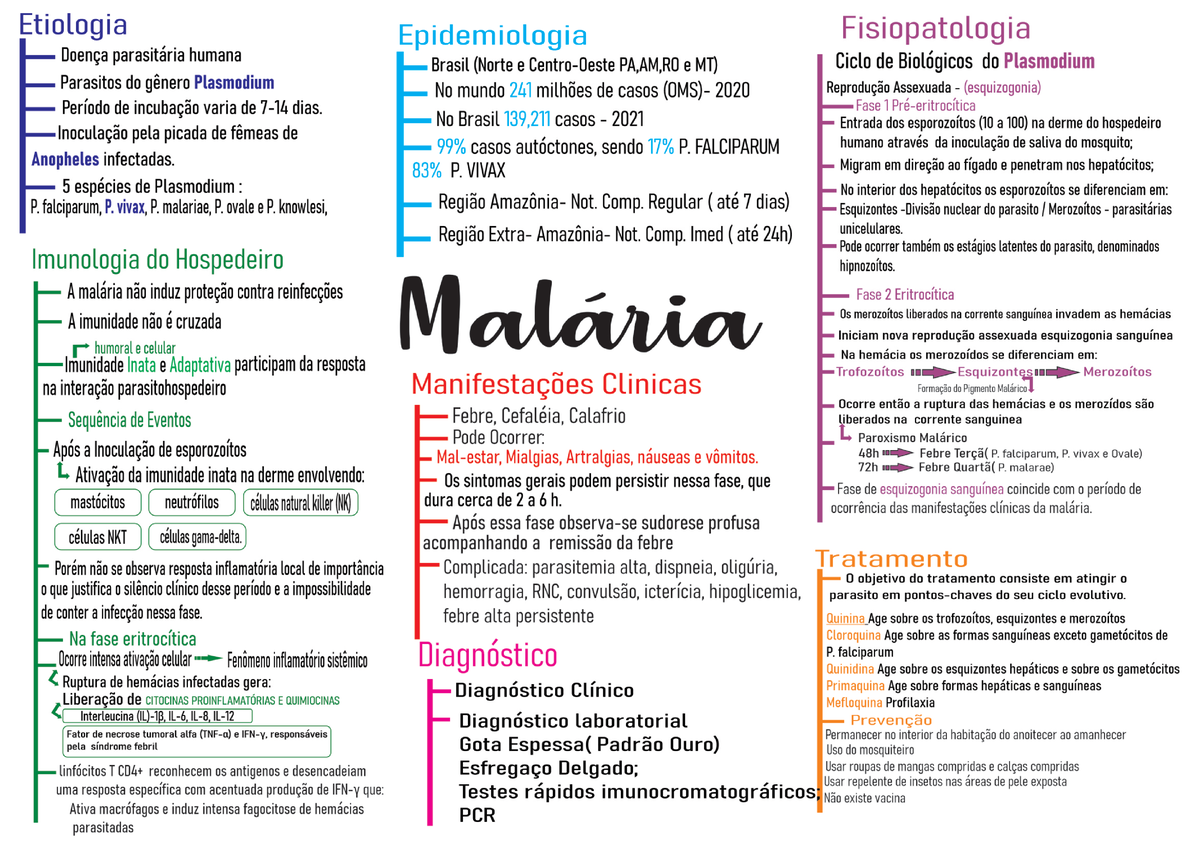
Malaria mapa mental Medicina Studocu
Cerebral malaria may be the most common non-traumatic encephalopathy in the world. The pathogenesis is heterogenous and the neurological complications are often part of a multisystem dysfunction. The clinical presentation and pathophysiology differs between adults and children. Recent studies have elucidated the molecular mechanisms of pathogenesis and raised possible interventions.

malaria infografía farmaadicta
MALARIA ETIOLOGÍA: causada por cualquiera de cinco especies: Plasmodium falciparum , Plasmodium vivax , Plasmodium ovale , Plasmodium malariae y Plasmodium knowlesi (parásitos) Familia: Plasmodiidae CARACTERÍSTICAS FAMILIA Parásitos protozoos del filo Apicomplexa, intracelulares y que parasitan eritrocitos y hepatocitos MECANISMO DE DAÑO

Mapa Mental Malaria PDF
Malaria, an important parasitic infectious disease since antiquity, remains a significant public health problem, being responsible for estimated 229 million cases and 409.000 deaths worldwide annually (World Health Organization, 2020). It is caused by protozoa of the genus Plasmodium and is transmitted by the bite of the female Anopheles mosquito.
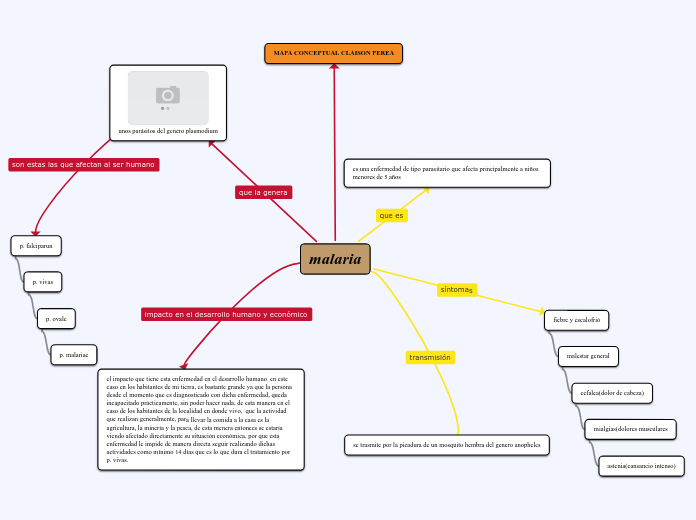
MALARIA Mind Map
Malaria parasites were present in 28% of participants, CMD in 10.3%, one or more psychotic symptoms in 13.9%, PTSD in 10.6%, lifetime suicidal thoughts in 7.9%, suicidal attempts in 1.9%, and hazardous drinking in 6.4%. We conducted bivariate and multivariate analyses on the association of malaria with the various mental disorders identified by.
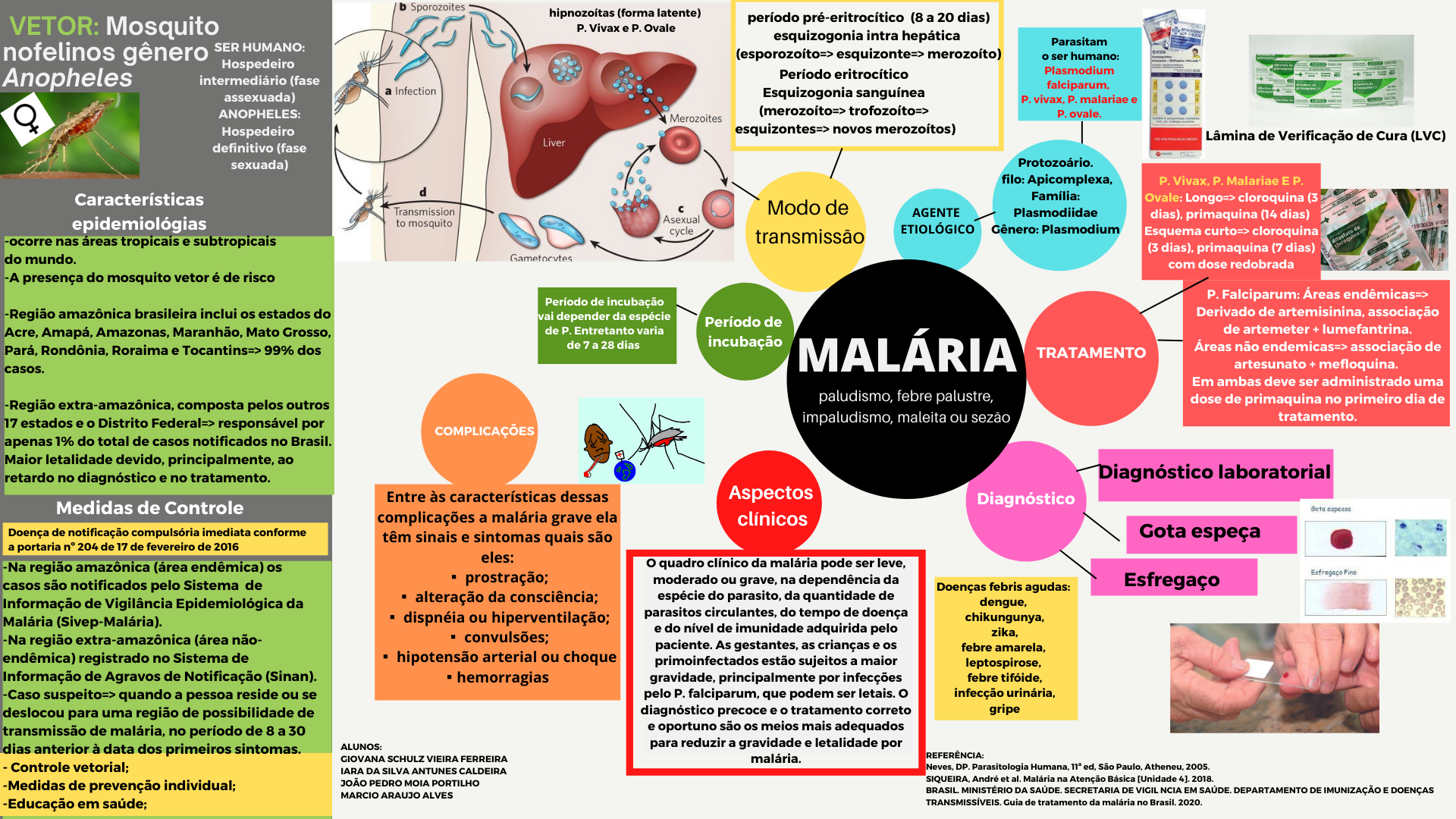
mapa mental malária Doenças Transmissíveis Prevenção e Cuidado
Seasons Greetings. With the year coming to a close, on behalf of the team at MAP, we wish you a wonderful holiday season and a Happy New Year! The Malaria Atlas Project (MAP) aims to disseminate free, accurate and up-to-date geographical information on malaria and associated topics.

MALARIA Mind Map
Malária 1. Ciclo da malária 2. Tipos de parasitas causadores da malária 2.1. Plasmodium malariae 2.2. Plasmodium vivax 2.3. Plasmodium ovale 2.4. Plasmodium falciparum 3. Sintomas 3.1. Menos comum 3.1.1. Perturbações sensoriais 3.1.2. Rigidez na nuca 3.1.3. Desorientação 3.1.4. Convulsões 3.1.5. Vômitos 3.1.6.
Malaria Mind Map
Epidemiology. Falciparum malaria is a leading cause of ill health, neuro-disability and death in tropical countries. Although 40% of the world's population is at risk, most transmission occurs in sub-Saharan Africa where children under the age of 5 years are most affected and the incidence of disease declines in older children with increasing immunity.
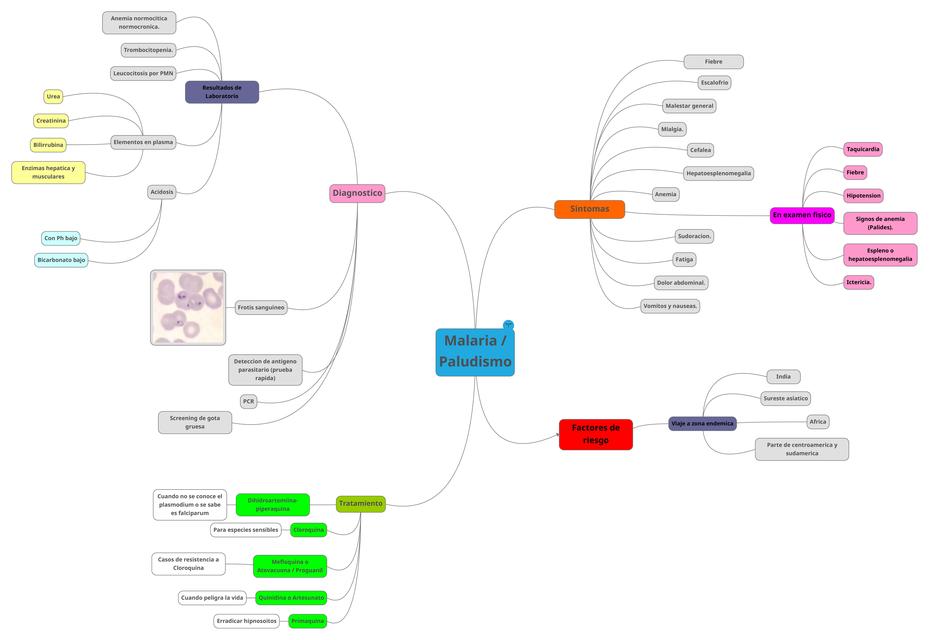
Mapa Mental Malaria uDocz
ArbovirosesMapa Mental e Flashcards --- https://drive.google.com/drive/folders/1ce1Q3C2svkwTZ8FkPMksBINTf2-z8LeW?usp=sharing Apostila Completa: https://go.ho.

La Malaria Mapa Conceptual
The modern medical literature implicates malaria, and particularly the potentially fatal form of cerebral malaria, with a risk of neurocognitive impairment. Yet historically, even milder forms of malaria were associated in the literature with a broad range of psychiatric effects, including disorders of personality, mood, memory, attention, thought, and behaviour. In this article, the history.
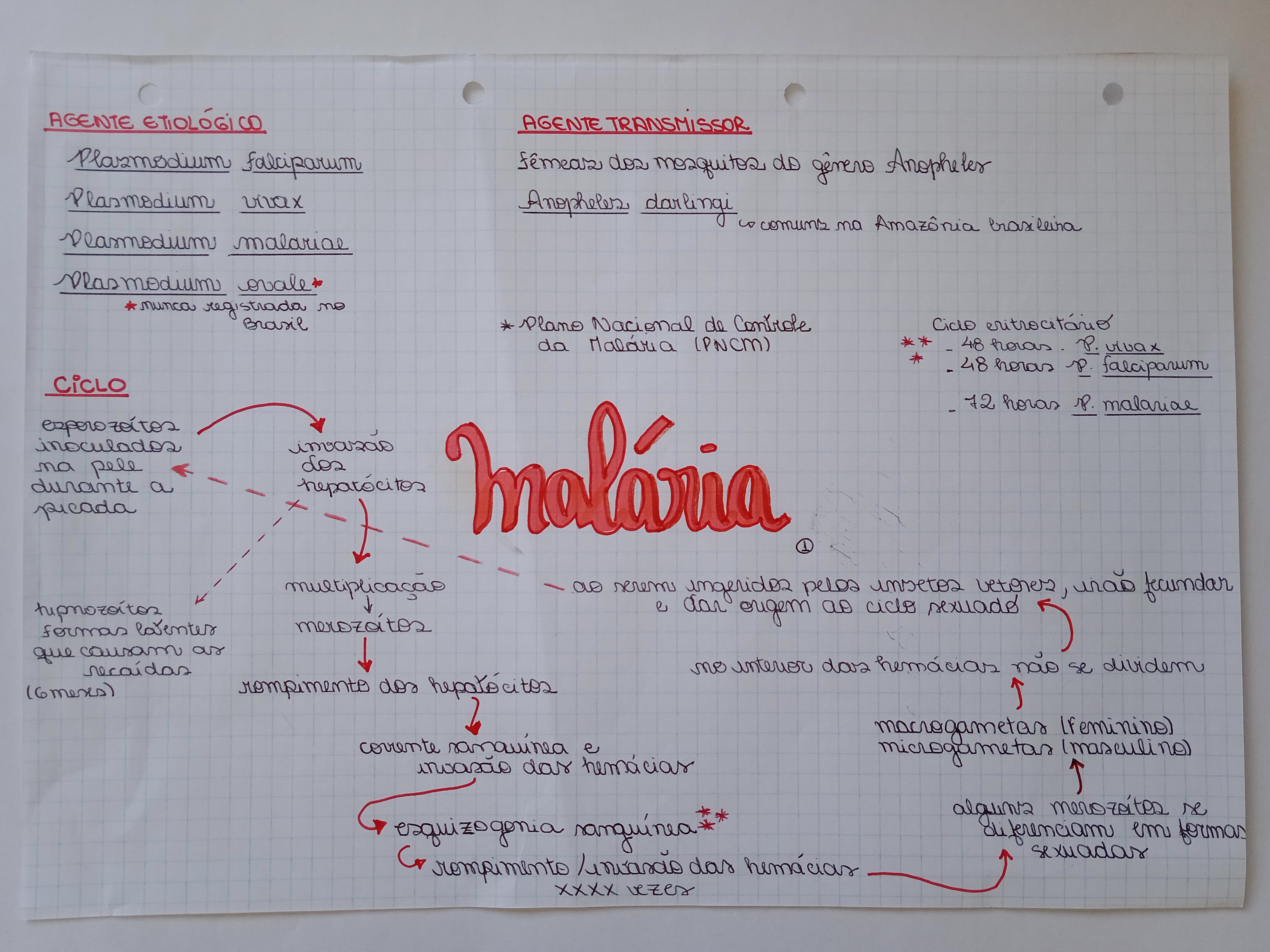
Mapa mental Malária Medicina Veterinária Preventiva e Zoonoses
Cerebral malaria by P. falciparum ranging from 0.001% to 37.200% in adult patients [2-4]. Severe complicated malaria is mainly caused by P. falciparum in form of cerebral malaria. A total of 110 million cases of malaria have been estimated from worldwide, of which P. falciparum causes 1 to 2 million death each year .

Mapa Mental Malária Flavia Teixeira Masson Hotmart
Malaria is one of the most severe public health problems worldwide. It is a leading cause of death and disease in many developing countries, where young children and pregnant women are the groups most affected. According to the 2021 World Malaria Report: Nearly half the world's population lives in areas at risk of malaria transmission in 87 countries and territories.